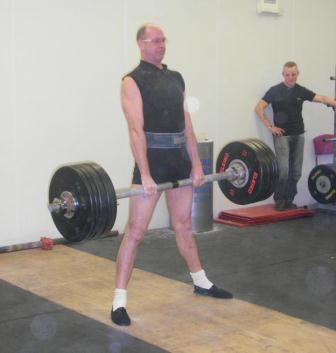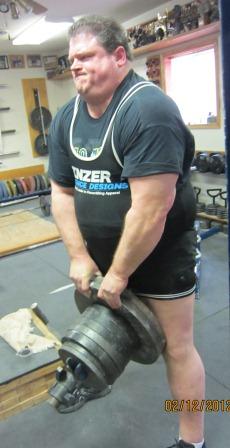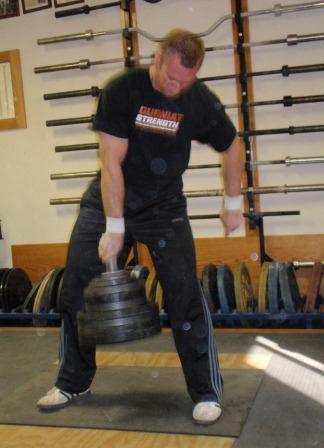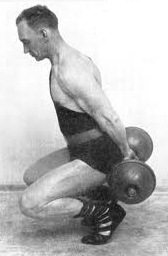The Fulton Bar Debate
by Al Myers
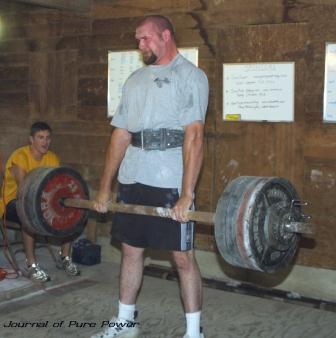
This is a picture of Matt Graham pulling a 2" Bar Overhand Deadlift of 540 pounds at the 2001 SuperGrip Challenge hosted by Kevin Fulton. (photo courtesy of Dan Wagman, who was there and competed in the meet as well).
I always enjoy a good discussion/debate on anything All-Round in nature. Well, these past couple of weeks there has been a very interesting discussion in the USAWA Discussion Forum regarding the Fulton Bar. If you have missed it – before you read today’s story it might be worthwhile to check it out so you will be “up to speed” on the subject. I usually try to stay neutral in my writings, and give out just the facts and stuff. But today I’m going to include a few of my opinions of the subject as well. So be prepared! I’m also going to “highlight” a few of the things that have been discussed in the forum, and then give an editorial on them. I plan to “go beyond” any comments I made in my forum replies. I will also not “name any names” as the opinions expressed here are strictly mine. Read the forum if you want that other information.
I also will keep this story as to what actually applies to the USAWA/IAWA. A little history on the Fulton Bar is in order first. Most know that the Fulton Bar is named after grip-sensation, All-Round Weightlifting Champion Kevin Fulton. Most DON’T know that originally the name was given to a dumbbell lift with a 2″ diameter handle. Over 3 years ago I wrote a blog covering this (https://www.usawa.com/the-fulton-dumbbell-deadlift/), but I’m going to repeat a piece of it here as well, as this story needs to be told more than once:
Back in the early 80’s at a odd lifting meet in Liberal, Kansas, meet director Bob Burtzloffincluded a thick-handled dumbbell deadlift in the contest. This dumbbell had a smooth 2 inch diameter handle. Wilbur Miller, the “Cimarron Kid” and Kansas lifting legend, was the hands on favorite to win this event. Wilbur has huge hands with long fingers and was very rarely beaten in any lifting event that involved grip strength. But this day was one of those rare days – when a young farm boy from Nebraska by the name of Kevin Fulton pulled off the upset! Upon Fulton’s winning – Bill Clark announced that this lift would be forever named the Fulton Lift. This eventually lead to the naming of the 2″ bar as the Fulton Bar along with the Fulton Dumbbell. As for Wilbur – upon the finish of the event he went back to the warm-up area and proceeded to pull more on this lift than he did in competition. He went home knowing that he may not have won the event on this day, but with the satisfaction of knowing he would next time!
The naming of the 2″ bar as the Fulton Bar in the USAWA became named that way later. I have checked back in old meet results, and to the best of my research have determined that the first Fulton Bar lifts done in the USAWA were performed in 1995. Bob Hirsh, USAWA Hall of Famer, performed lifts at a couple of record days (Arts Birthday Bash & the Buckeye Record Breakers) using the Fulton Bar. He was one of the first record-setters. At this point these lifts were called numerous things, like Fulton Deadlift with knuckles front, Fulton Deadlift Reverse Grip, Fulton Deadlift with Overgrip, or Fulton Deadlift with alternate grip. Nothing was consistent. The Fulton Bar Lifts really never “took off” in the USAWA till 1999 when Kevin Fulton started using the Fulton Bar in his annual SuperGrip Challenges in Litchfield, Nebraska. Now the story gets real interesting. In the beginning in the USAWA the deadlift with the Fulton Bar using an Alternate Grip was called the Two Hands Fulton Deadlift! Exactly the same name that the IAWA(UK) uses today to refer to the lift where an overhand grip (with hook) is used on the 2 inch bar!!! This is backed up in several reliable sources – ie old entry forms, meet results, and even in the initial USAWA Rulebook!!!!
This comes directly from the 2003 USAWA Rulebook Edition (which is considered the original USAWA rulebook):
F23. Two-Hand Fulton Deadlift– The rules of the deadlift apply with two exceptions. 1. The bar must be at least 1-15/16 inches in diameter. 2. Foot placing is optional. The hook grip is allowed.
Nothing is mentioned about a Ciavattone Grip being used, or having the knuckles forward. So you see – confusion in the naming of these lifts went back to the very beginning. The USAWA lift Deadlift – Fulton Bar, Ciavattone Grip was not placed in the USAWA rulebook till the 2009 Edition. However, it was contested several times in USAWA competition before then and records were being kept in it, which makes no sense to me because if it was not official in the Rulebook with established approved written rules then it shouldn’t be present in the Official Record List. But back then the USAWA operated like the Wild West – no written law and the guy with the fastest draw was named Sheriff. Policies seemed to change on a whim and the town folks weren’t asked.
Which brings us to the TOP ALL-TIME Deadlift – Fulton Bar, Ciavattone Grip in the USAWA Record List. This GREAT RECORD is held by Matt Graham with a 540 lb. lift performed at the 2001 SuperGrip Challenge held at Kevin Fulton’s place. However, he did this lift by using a hook grip on the 2″ bar!!!! I have knowledge of this from very several reliable sources (including from Matt!). First of all, anyone who can hook grip a Fulton Bar is in a “class of their own” as most can’t even touch fingers on it. I’m going to defend Matt here. First of all, when he did it it WAS NOT against any USAWA Rule, and is not his fault at all that it is now in the USAWA Record List. The lift was listed in the meet results as “2” deadlift overhand”, and the meet results were typed by Kevin Fulton himself. Kevin was too humble to even identify the lift correctly (ie Fulton Deadlift) that beared his name in the results !!! The problem arises when these results were put into the record list without a proper rule in place first. With no official rule – the lift is just an exhibition lift with the rules set at the moment by the meet director, which may change the next time the lift is contested. Of course, there could have been others that “hooked” the Fulton Bar in this meet (I doubt it!) and set USAWA records as well, but because it was not 540 pounds no one notices. This includes other meets as well during that time period. Again, the first written USAWA rule for the Deadlift – Fulton Bar, Ciavattone Grip came out in the 2009 Rulebook (3rd Edition) and these previous records just got “incorporated” into the Record List under the new name.
I know I have gotten extremely “long winded” with all this, and I’m sure most have quit reading by now. But I’ve just covered some of the history of the Fulton Bar and I haven’t even GOT to my opinions yet!!! I still have MUCH MORE I could say on this subject, but I guess I better save it for another day….
